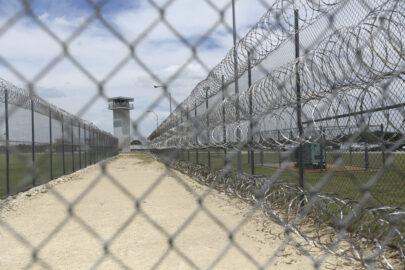How Prisons Became Heat Traps
A dozen state prison systems across the South continue to resist climate-control reforms after building human ovens. Image: Adobe
Image: Adobe
Note: Jimmy Iakovos is a pseudonym for the author, who is incarcerated in a Georgia prison.
Before the days of modern air-conditioning, homes and businesses in the Southeastern United States were built with 10- to 14-foot ceilings, large windows and tall doors with transoms to facilitate air flow. Otherwise, the enclosed area will trap the heat and exceed outside temperatures. Poor homes had 10-foot ceilings; anything less was considered uninhabitable.
Many decades ago, prisons were built with 10-foot ceilings and concrete walls up to two feet thick, which insulated the interiors from heat like adobe homes built in deserts. The walls were painted white to deflect the sun. Large windows had bars, but could be opened, and worked in tandem with lots of ceiling fans to create a breeze.
Now, prisons are designed to accommodate the population boom. Poured concrete cell units are trucked in and stacked like Legos before being sealed together with foam-board siding. A steel door has a two-inch gap at the bottom, and on the opposite wall there’s a window slot — 6 inches wide and 48 inches tall — with a steel flap at the bottom to match. Mounted on the ceiling are two small exhaust fans. There’s your cross-breeze.
“Fights are guaranteed if the fan appears to have been repositioned. To keep the peace, both fans face the farthest wall where there are no cells.”
The Georgia Department of Corrections is one of a dozen state prison systems in the South that has successfully resisted universal climate control. Most facilities are “partially cooled,” which means there’s air-conditioning somewhere in there; just not necessarily serving most of the living units.
Two 36-inch fans on the tier shuffle some air around, high up on support poles, out of reach of tampering.
“Fights are guaranteed if the fan appears to have been repositioned to favor any one cell,” Kevin*, currently serving a life sentence in a medium-security Georgia prison, told Filter. “To keep the peace, both fans face the farthest wall where there are no cells.”
No matter. There’s less and less space for air to circulate anyway. Today’s cells have been whittled down to 8 feet by 6 feet, with seven-foot ceilings. Inside each is a steel bunk that’s three feet wide, a steel desk with a chair welded on, a steel locker and a steel toilet below a small sink. It’s now common to have three-level bunks, which leave the top resident about 18 inches of clearance between mattress pad and ceiling. An extra locker is crammed into these cells too.
Instead of the traditional and functional white paint, many of living units are a dark blue that draws in heat like a sponge. You might wonder if in the summer months it’s a blessing that the windows are few and small, but darkness helps little when one is inside an oven.
Prisons cells in the South can reach 120 degrees Fahrenheit or more. Raven*, also serving a life sentence, recalled an officer recently coming in with a meat thermometer that read 109 degrees. It was in his breast pocket, but it was also 9 p.m. You can make coffee by just putting the freeze-dried powder in cold water and leaving the cup on the windowsill for half an hour.
“Ramen soups will cook there in the same amount of time,” Raven told Filter. “Not a hot meal, but no one desires one anyway.”
GDC regulations say almost nothing about extreme heat protections, other than the following:
“During hot weather, all Correctional Officers and Supervisory personnel shall be particularly alert to the early detection of symptoms and the prevention of cases of heat exhaustion. New inmates and others who have not acclimated to the environment will require the particular attention of supervisory personnel.”
GDC spokesperson Lori Benoit did not answer Filter‘s inquiry as to whether the department currently has enough personnel to be in compliance, but said that “extra precautions” are taken when outdoor temperatures exceed 90 degrees.
“Some specific steps include increasing the number of ice calls and coolers throughout the dorms, adding additional fans, additional rounds in admin segregation, reduction in activity and allowing offenders to dress accordingly,” Benoit told Filter. “For outside details, additional breaks in shaded areas are mandated, water intake is increased, hats and sunscreen are provided and temperatures are closely monitored.”
They can never find the hats. None of the outside work that needs to be done is in the shade; bean fields that stretch on for miles have no shaded areas.

Once or twice a day, a 48-quart ice chest may be filled and brought to the dorm to be scooped up by 120 prisoners. It is gone in seconds. That is, if the ice machine is not broken. It doesn’t matter how many ice calls and coolers are approved if the ice machine is broken.
“Dousing one’s clothing with water and just lying still in the puddle on a cooler concrete floor is an old means of riding out the heat in the solitary confinement cells,” Raven said.
That doesn’t work in general population dorms, however. Not because they’re a communal space, but because the water messes up the floor wax.
“And that matters,” Kevin said. “There will be a formal inspection conducted between the hours of 9 and 10 a.m. each day — before it becomes too hot. Though an entire prison is rarely inspected every day, every living unit is potentially targeted. So all must be ready to pass, or face loss of privileges. Such as ice.”
Even if commissary fans were affordable and durable, it wouldn’t matter if there’s no power to turn them on.
Commissaries sell an 8-inch fan for $32.17. These last maybe two years or so. Sometimes people buy them to trade at a loss for drugs, to someone who will then resell them for less than commissary but more than their investment. The thing is that even if the commissary offered something cheap and durable, it wouldn’t matter if there’s no power to turn it on. Cells have wall outlets, but many have been covered or removed by wardens if they notice discoloration and suspect they’ve been used to light cigarettes with a pencil lead popper. That’s especially common in the mental health dorms. So there are plenty of fans available if you look at it that way, just few that can actually be used.
Contraband substances provide a little reprieve from whatever ails a body, such as being slowly baked to death. One fringe benefit of the summer weather here is that tobacco absorbs moisture from the air, and while that makes cigarettes harder to light it also makes them slower to burn. Same with marijuana, when available. Both are soothing; we have little else that is. People smoke as much as they can, thickening the still air.
“[Prisoners start] developing tics and behaviorisms that begin automatically when their body temperature reaches a certain point. Some become violent; others so lethargic as to having to be cajoled and led to chow,” Kevin said. “Suicide [is] a means of escaping the mind-bending heat and humidity. They die from just giving up on life in such misery.”
GDC has claimed to take issue with the unprecedented rates of drug use, homicides, suicides and staff vacancies. Central air-conditioning would not resolve any of these, but it would decrease all of them.
*Names have been changed to protect sources.
Your support is crucial…With an uncertain future and a new administration casting doubt on press freedoms, the danger is clear: The truth is at risk.
Now is the time to give. Your tax-deductible support allows us to dig deeper, delivering fearless investigative reporting and analysis that exposes what’s really happening — without compromise.
Stand with our courageous journalists. Donate today to protect a free press, uphold democracy and unearth untold stories.







You need to be a supporter to comment.
There are currently no responses to this article.
Be the first to respond.